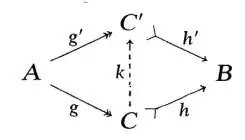I'm stuck on Exercise 5.2.1 of Goldblatt's "Topoi: A Categorial Analysis of Logic":
Given a function $f:A\to B$, if $h\circ g: A\twoheadrightarrow C\rightarrowtail B$ and $h'\circ g': A\twoheadrightarrow C'\rightarrowtail B$ are two different epic-monic factorisations of $f$ (i.e. $f=h\circ g=h'\circ g'$), then there exists a unique $k:C\to C'$ such that
commutes, and furthermore $k$ is iso in $\mathbf{Set}$.
The rest of the section seems okay. It gives a categorical proof in any topos. However, I'd like a set-theoretic proof please.
I've tried defining $k: C\to C'$ by way of equivalence classes; namely, by letting $k(c)=g'(\gamma)$ for some $\gamma$ with $c=g(\gamma)$, so that since $g$ in onto, I can iron out any ambiguity by saying $\gamma\sim_{g}\delta$ iff $g(\gamma)=g(\delta)$, then go from there. (Do you see what I mean?) I can't get it to work.
Please help :)
